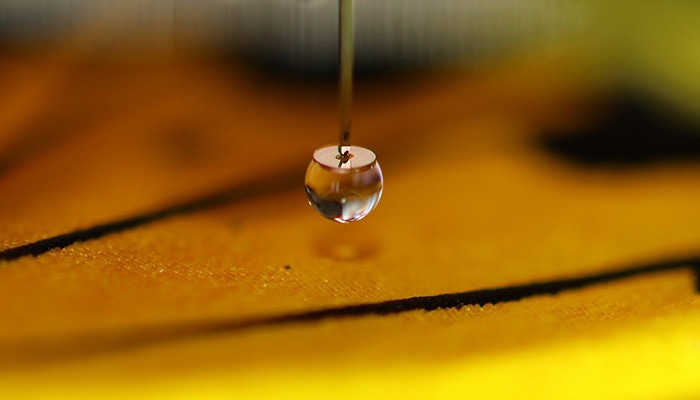Nov 28 2017
Wetting is considered to be an everyday phenomenon that depicts how well liquid spreads on a surface. When water comes into contact with an extremely ‘superhydrophobic’ or water-repellent surface, droplets bead up and then roll off effortlessly.
Researchers from Aalto University have now developed a measurement technique known as Scanning Droplet Adhesion Microscopy (SDAM) in order to understand and characterize the wetting properties of superhydrophobic materials.
 The droplet probe of the microscope on a superhydrophobic golden birdwing (Troides aeacus) butterfly wing. Photo: Matti Hokkanen / Aalto University
The droplet probe of the microscope on a superhydrophobic golden birdwing (Troides aeacus) butterfly wing. Photo: Matti Hokkanen / Aalto University
Our novel microscope will promote the understanding of how wetting emerges from surface microstructures. The measuring instrument can also detect microscopic defects of the surface, which could allow coating manufacturers to control the quality of materials. Defects in self-cleaning, anti-icing, anti-fogging, anti-corrosion or anti-biofouling products can impeach the functional integrity of the whole surface.
Professor Robin Ras from Aalto University School of Science.
SDAM is very sensitive and 1000 times more accurate than the most advanced wetting characterization methods. It is also capable of measuring minuscule features and inconsistencies of surfaces containing microscale resolution. Currently available instruments for measuring droplet adhesion forces can only detect forces down to a micronewton level – not adequately sensitive for superhydrophobic surfaces.
We have used a droplet of water to measure the water-repellent properties of a surface by recording the very tiny nanonewton force when the droplet touches the surface and when it separates from the surface. By measuring on many locations with micrometer spacing between the measurement points, we can construct a two-dimensional image of the surface’s repellency, called a wetting map.
Professor Quan Zhou from Aalto University School of Electrical Engineering.
Wetting maps are a fresh concept for hydrophobic surface characterization and they open a window for exploring structure-property relationships in surface wetting.
‘Contact angle measurement’, up to now, has been the ideal method used for measuring wetting properties of surfaces. It is considered to be prone to inaccuracies, though, for surfaces that are greatly repellent to liquid. SDAM, unlike contact angle measurement, does not need a direct line of sight, which permits measuring uneven surfaces such as biological surfaces or fabrics. SDAM also has the potential to detect wetting properties of microscopic functional features that were earlier extremely hard to measure. Those microscopic features are vital in many chemical sensors, biochips, and microelectromechanical systems and components.
The research is carried out by an interdisciplinary team from three schools of Aalto University: School of Electrical Engineering, School of Science, and School of Chemical Engineering. Ville Liimatainen, Maja Vuckovac, Ville Jokinen, Veikko Sariola, Matti Hokkanen, Quan Zhou and Robin Ras are the researchers who were involved in the study.